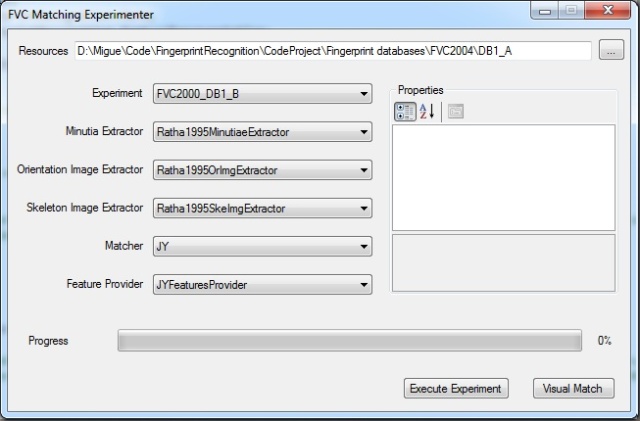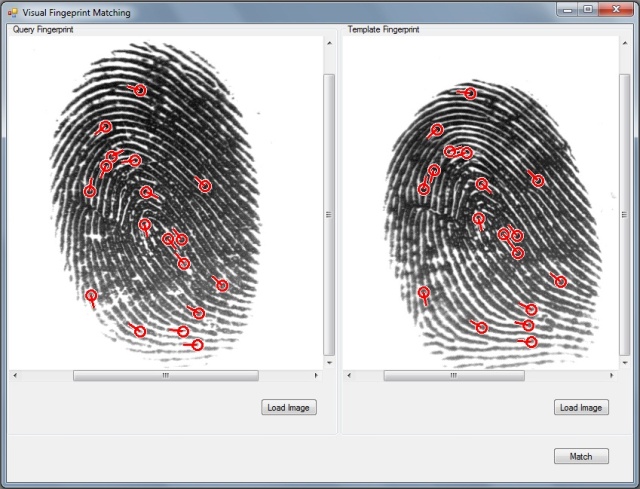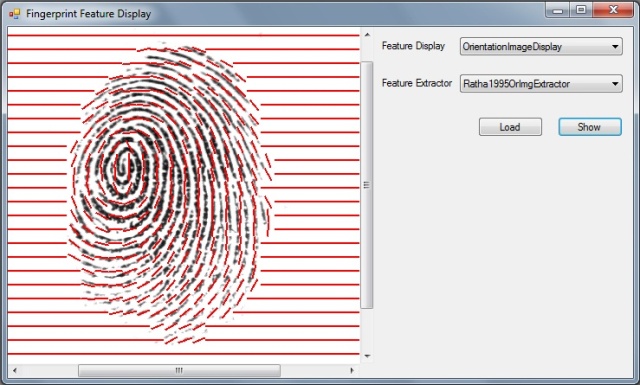Introduction
Fingerprint recognition [1] is an active research area nowadays. An important component in fingerprint recognition systems is the fingerprint matching algorithm. According to the problem domain, fingerprint matching algorithms are classified in two categories: fingerprint verification algorithms and fingerprint identification algorithms. The aim of fingerprint verification algorithms is to determine whether two fingerprints come from the same finger or not. On the other hand, the fingerprint identification algorithms search a query fingerprint in a database looking for the fingerprints coming from the same finger.There are hundreds of papers concerning to fingerprint verification but, as far as we know, there is not any framework for fingerprint verification available on the web. So, you must implement your own tools in order to test the performance of your fingerprint verification algorithms. Moreover, you must spend a lot of time implementing algorithms of other authors to compare with your algorithms. This was our motivation to put our fingerprint verification framework available for everyone.
The most closely related work to our framework is the FVC-onGoing web system. This system has the following limitations:
- You do not have access to any algorithm but yours.
- It is not a framework; so, you cannot reuse any software component.
- It cannot be used with educational purpose because students cannot see how the algorithms work.
- After performing an experiment using a database (standard or hard) you must wait 30 days to perform another experiment using the same database.
- You do not have control over the fingerprint databases. Thus, you cannot use your own databases neither modify the existing ones.
- You do not have access to the fingerprints that your algorithm fails matching. Hence, you cannot analyze why the algorithm fails in order to fix your code.
- You cannot create an experiment with a custom protocol for performance evaluation.
Our framework is implemented in C# with .Net Framework for two main reasons. First, C# has become one of the most popular programming languages. Second, the technologies, tools and class libraries available on .Net Framework save us a lot of time of coding.
Our framework allows performing fingerprint verification experiments for databases B of FVC2000, FVC2002 and FVC2004; and databases A of FVC2002 and FVC2004. In this experiments, we use the performance indicators of the Fingerprint Verification Competitions [2] (EER(%), FMR100(%), FMR1000(%), ZeroFMR(%), Time(ms) and ROC curves). Additionally, you can include experiments with a custom evaluation protocol or different databases.
We implemented the fingerprint verification algorithms proposed by Cappelli et al. [12], Tico and Kuosmanen [3], Jiang and Yau [4], Medina-Pérez et al. [5, 6, 8, 13], and Qi et al. [9]. It is important to highlight that, despite the algorithm of Qi et al. is a combination of a minutiae matching algorithm with an orientation based algorithm, we implemented only the minutiae matching algorithm. We also implemented the feature extraction algorithms proposed by Ratha et al. [10] and the orientation image extractor proposed by Sherlock et al. [11]. This framework allows you to include new fingerprint matching algorithms as well as new feature extraction algorithms with minimum effort and without recompiling the framework.
One of the goals that we kept in mind while developing this framework was to achieve class interfaces as simple as possible. This way, adding new algorithms is pretty straightforward.
We hope this work motivates you and more people to collaborate with us in order to implement more algorithms.
In this article we briefly explain how:
- to perform fingerprint verification experiments,
- to see the matching minutiae after performing an experiment with a minutiae based algorithm,
- to compute and display features from certain fingerprint,
- to integrate your algorithms to the framework.
Before using the framework
With this article, we provide the following files:- FingerprintRecognition.zip: The source files of our framework.
- Help.zip: The source code documentation.
- FVC2000
- FVC2002
- FVC2004
- DB1_B: http://bias.csr.unibo.it/fvc2004/Downloads/DB1_B.zip
- DB2_B: http://bias.csr.unibo.it/fvc2004/Downloads/DB2_B.zip
- DB3_B: http://bias.csr.unibo.it/fvc2004/Downloads/DB3_B.zip
- DB4_B: http://bias.csr.unibo.it/fvc2004/Downloads/DB4_B.zip
- DB1_A: http://biometrics.cse.msu.edu/fvc04db/DB1_A.tar.gz
- DB2_A: http://biometrics.cse.msu.edu/fvc04db/DB2_A.tar.gz
- DB3_A: http://biometrics.cse.msu.edu/fvc04db/DB3_A.tar.gz
- DB4_A: http://biometrics.cse.msu.edu/fvc04db/DB4_A.tar.gz
Running a fingerprint verification experiment
Extract the file “FingerprintRecognition.zip” and build the solution. Then you can debug the project “FR.FVCExperimenter” or you can execute “FR.FVCExperimenter.exe” in the directory containing the generated assemblies. The following window will open:Introduction
Fingerprint recognition [1] is an active research area nowadays. An important component in fingerprint recognition systems is the fingerprint matching algorithm. According to the problem domain, fingerprint matching algorithms are classified in two categories: fingerprint verification algorithms and fingerprint identification algorithms. The aim of fingerprint verification algorithms is to determine whether two fingerprints come from the same finger or not. On the other hand, the fingerprint identification algorithms search a query fingerprint in a database looking for the fingerprints coming from the same finger.There are hundreds of papers concerning to fingerprint verification but, as far as we know, there is not any framework for fingerprint verification available on the web. So, you must implement your own tools in order to test the performance of your fingerprint verification algorithms. Moreover, you must spend a lot of time implementing algorithms of other authors to compare with your algorithms. This was our motivation to put our fingerprint verification framework available for everyone.
The most closely related work to our framework is the FVC-onGoing web system. This system has the following limitations:
- You do not have access to any algorithm but yours.
- It is not a framework; so, you cannot reuse any software component.
- It cannot be used with educational purpose because students cannot see how the algorithms work.
- After performing an experiment using a database (standard or hard) you must wait 30 days to perform another experiment using the same database.
- You do not have control over the fingerprint databases. Thus, you cannot use your own databases neither modify the existing ones.
- You do not have access to the fingerprints that your algorithm fails matching. Hence, you cannot analyze why the algorithm fails in order to fix your code.
- You cannot create an experiment with a custom protocol for performance evaluation.
Our framework is implemented in C# with .Net Framework for two main reasons. First, C# has become one of the most popular programming languages. Second, the technologies, tools and class libraries available on .Net Framework save us a lot of time of coding.
Our framework allows performing fingerprint verification experiments for databases B of FVC2000, FVC2002 and FVC2004; and databases A of FVC2002 and FVC2004. In this experiments, we use the performance indicators of the Fingerprint Verification Competitions [2] (EER(%), FMR100(%), FMR1000(%), ZeroFMR(%), Time(ms) and ROC curves). Additionally, you can include experiments with a custom evaluation protocol or different databases.
We implemented the fingerprint verification algorithms proposed by Cappelli et al. [12], Tico and Kuosmanen [3], Jiang and Yau [4], Medina-Pérez et al. [5, 6, 8, 13], and Qi et al. [9]. It is important to highlight that, despite the algorithm of Qi et al. is a combination of a minutiae matching algorithm with an orientation based algorithm, we implemented only the minutiae matching algorithm. We also implemented the feature extraction algorithms proposed by Ratha et al. [10] and the orientation image extractor proposed by Sherlock et al. [11]. This framework allows you to include new fingerprint matching algorithms as well as new feature extraction algorithms with minimum effort and without recompiling the framework.
One of the goals that we kept in mind while developing this framework was to achieve class interfaces as simple as possible. This way, adding new algorithms is pretty straightforward.
We hope this work motivates you and more people to collaborate with us in order to implement more algorithms.
In this article we briefly explain how:
- to perform fingerprint verification experiments,
- to see the matching minutiae after performing an experiment with a minutiae based algorithm,
- to compute and display features from certain fingerprint,
- to integrate your algorithms to the framework.
Before using the framework
With this article, we provide the following files:- FingerprintRecognition.zip: The source files of our framework.
- Help.zip: The source code documentation.
- FVC2000
- FVC2002
- FVC2004
- DB1_B: http://bias.csr.unibo.it/fvc2004/Downloads/DB1_B.zip
- DB2_B: http://bias.csr.unibo.it/fvc2004/Downloads/DB2_B.zip
- DB3_B: http://bias.csr.unibo.it/fvc2004/Downloads/DB3_B.zip
- DB4_B: http://bias.csr.unibo.it/fvc2004/Downloads/DB4_B.zip
- DB1_A: http://biometrics.cse.msu.edu/fvc04db/DB1_A.tar.gz
- DB2_A: http://biometrics.cse.msu.edu/fvc04db/DB2_A.tar.gz
- DB3_A: http://biometrics.cse.msu.edu/fvc04db/DB3_A.tar.gz
- DB4_A: http://biometrics.cse.msu.edu/fvc04db/DB4_A.tar.gz
Running a fingerprint verification experiment
Extract the file “FingerprintRecognition.zip” and build the solution. Then you can debug the project “FR.FVCExperimenter” or you can execute “FR.FVCExperimenter.exe” in the directory containing the generated assemblies. The following window will open:
In the “Resources” text box, specify the path of the database that you are going to use, for example: “D:\PR Databases\Fingerprints\FVC2004\DB1_B”. Select the proper experiment type in the combo box with label “Experiment”. Use the combo boxes “Minutia Extractor”, “Orientation Image Extractor” and “Skeleton Image Extractor“ to select the algorithms that will be used to compute the basic features (minutiae, orientation image and skeleton image).
Use the combo box with label “Matcher” to select a fingerprint verification algorithm, and the combo box with label “Feature Provider” to select the algorithm that will be used to store and retrieve the features for the selected matcher. Despite that we implemented only one feature provider for each matcher, there are possible scenarios where you may have multiple feature providers for each matcher.
The grid with label “Properties” allows changing the parameters of any selected algorithm.
Click on “Execute Experiment” button to run the experiment. This experiment uses the evaluation protocol of the Fingerprint Verification Competitions [2]. The performance indicators computed in this experiments are: EER(%), FMR100(%), FMR1000(%), ZeroFMR(%), Time(ms) and ROC curves. These indicators are saved in a file which name is formed by the name of the matching algorithm concatenated with ".Summary.csv". This file is saved in a folder by the name of "Results" in the same folder where the fingerprints are stored. Two more files are saved, one file containing the false matching fingerprints and the other containing the false non matching fingerprints.
If you want to match two fingerprints and verify the coincident minutiae, then click the “Visual Match” button which will open the “Visual Fingerprint Matching” form. Load the fingerprints that you want to compare and click the “Match” button. The feature extractors and matcher selected in the “FVC Experimenter” are also used here to perform the fingerprint matching. The following is an example of matching two fingerprints:

Visualizing features
If you want to visualize features for certain fingerprint then you can use “FR.FeatureDisplay” project. In “Fingerprint Feature Display” form, you can change the feature extractor and feature display. In the framework, we include classes to visualize minutiae, orientation image and skeleton image.The following is an example visualizing the orientation image of a fingerprint:

Adding new algorithms to the framework
The first thing that you need to know is that you do not need to modify the applications of the framework in order to recognize your algorithms because we use Reflection to load all algorithms dynamically at execution time.You may create as many assemblies as you want in the directory containing the framework. For each new assembly, go to the properties and set the output path with value “..\bin\Release\”.
In order to add a new feature extractor, you must inherit from the generic class
FeatureExtractor<T> and implement the method ExtractFeatures(Bitmap image). For example, suppose that you want to create an extractor for features of type MyFeature, then you could implement a class like the following:public class MyFeatureExtractor : FeatureExtractor<MyFeature>
{
public override MyFeature ExtractFeatures(Bitmap image)
{
// Place here your code to extract features
}
}
In case that your new features are built upon some existing features then you can do like follows:public class MyFeatureExtractor : FeatureExtractor<MyFeature>
{
public FeatureExtractor<List<Minutia>> MtiaExtractor { set; get; }
public FeatureExtractor<OrientationImage> OrImgExtractor { set; get; }
public override MyFeature ExtractFeatures(Bitmap image)
{
try
{
var mtiae = MtiaExtractor.ExtractFeatures(image);
var orImg = OrImgExtractor.ExtractFeatures(image);
return ExtractFeatures(mtiae, orImg);
}
catch (Exception e)
{
if (MtiaExtractor == null)
throw new InvalidOperationException("Cannot extract MyFeature: Unassigned minutia list extractor!", e);
if (OrImgExtractor == null)
throw new InvalidOperationException("Cannot extract MyFeature: Unassigned orientation image extractor!", e);
throw;
}
}
public MyFeature ExtractFeatures(List<Minutia> mtiae, OrientationImage orImg)
{
// Place here your code to extract features
}
}
For each feature extractor you must create a resource provider.
Resource providers allow saving (retrieving) to (from) file the
resources associated to fingerprints. The framework includes resource
providers for extractors of minutiae (MinutiaListProvider), orientation image (OrientationImageProvider), and skeleton image (SkeletonImageProvider). The following is an example of a resource provider for the feature extractor defined above.public class MyFeatureProvider : ResourceProvider<MyFeature>
{
public MinutiaListProvider MtiaListProvider { get; set; }
public OrientationImageProvider OrImgProvider { get; set; }
public override string GetSignature()
{
return "myf";
}
public override bool IsResourcePersistent()
{
return true;
}
protected override MyFeature Extract(string fingerprint, ResourceRepository repository)
{
try
{
var mtiae = MtiaListProvider.GetResource(fingerprint, repository);
var orImg = OrImgProvider.GetResource(fingerprint, repository);
return featureExtractor.ExtractFeatures(mtiae, orImg);
}
catch (Exception e)
{
if (MtiaListProvider == null)
throw new InvalidOperationException("Unable to extract MyFeature: Unassigned minutia list provider!", e);
if (OrImgProvider == null)
throw new InvalidOperationException("Unable to extract MyFeature: Unassigned orientation image provider!", e);
throw;
}
}
private MyFeatureExtractor featureExtractor = new MyFeatureExtractor();
}
Now, it is time to create a new fingerprint matching algorithm. Suppose that you want to match features of type MyFeature, then you must create a matcher like this:public class MyMatcher : Matcher<MyFeature>
{
public override double Match(MyFeature query, MyFeature template)
{
// Place here your code to match fingerprints
}
}
In case that you are implementing a minutia matching algorithm then you should modify the above code as follows:public class MyMatcher : Matcher<MyFeature>, IMinutiaMatcher
{
public override double Match(MyFeature query, MyFeature template)
{
List<MinutiaPair> matchingMtiae;
return Match(query, template, out matchingMtiae);
}
public double Match(object query, object template, out List<MinutiaPair> matchingMtiae)
{
// Place here your code to match fingerprints
}
}
Sumber: http://www.codeproject.com/Articles/97590/A-Framework-in-C-for-Fingerprint-Verification
Tidak ada komentar:
Posting Komentar
Silahkan Komentar disini.....